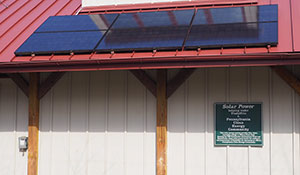Planning for Solar Power at the Municipal Level

Comprehensive Plan
Until recently, comprehensive plans have not typically addressed solar power, particularly utility-scale solar facilities; however, they can and should address this issue, both from a land use perspective and from a community facilities/utilities perspective. In fact, the state Municipalities Planning Code includes the following provision on energy and comprehensive plans:
Section 301.1. Energy Conservation Plan Element. To promote energy conservation and the effective utilization of renewable energy sources, the comprehensive plan may include an energy conservation plan element which systematically analyzes the impact of each other component and element of the comprehensive plan on the present and future use of energy in the municipality, details specific measures contained in the other plan elements designed to reduce energy consumption and proposes other measures that the municipality may take to reduce energy consumption and to promote the effective utilization of renewable energy sources.
Municipal comprehensive plans should support solar power in their goals section. Solar power goals can take two major forms. First, the municipality may choose to support the use of solar power for its own facilities, either by purchasing solar power or by installing solar panels on its buildings and property. Second, municipalities may want to encourage solar power throughout the community, either as an accessory use or as a primary use as a grid-scale solar facility.
For communities that want to allow grid-scale solar facilities, the comprehensive plan should identify the most appropriate locations, based on community characteristics and goals. As part of this analysis, transmission power lines will need be mapped and potential properties for solar facilities near these lines identified. Some may be appropriate for grid scale solar facilities and some may not be appropriate because of nearby residential properties, scenic viewsheds, active farmland, natural areas, historic characteristics, and other factors.
Some municipalities may want to set a goal for solar power in their community, perhaps having a goal of meeting 25% of the whole community's electricity needs via solar power generation located in the community itself. If this is the case, a more sophisticated analysis will need to be done in the comprehensive plan, including an estimate of electric demand and an identification of all the properties that could be used for grid scale solar needed to meet this demand. A certain amount of demand will be met by accessory use solar panels added to existing properties.
Sustainability, Climate Action, Greenhouse Gas Reduction, and Energy Transition Plans
Nowadays, many communities are creating sustainability, climate action, greenhouse gas reduction, and energy transition plans. These plans should support all types of solar power facilities.

